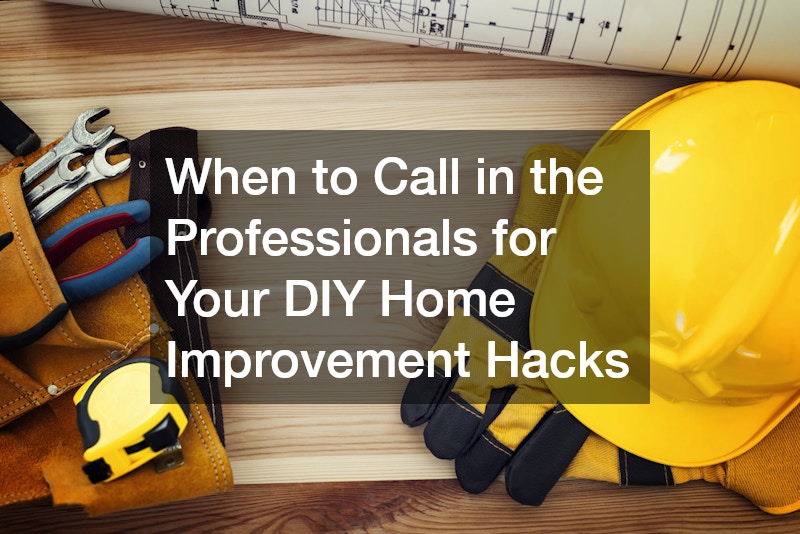Your DIY Vs. Non-DIY Guide What Can You Do at Home?

Humans are created to love work, although most detest it. There are things we like to do with our skills and experiences. These, at times, shine a light on our talents. However, there are other areas where we must get help from other professionals. In this DIY guide, we delve into things you can handle and those you’ll need help with.
1. Home Safety Inspection

Do you live in a house constructed before 1978? If you aren’t sure about the kind of paint used on its walls, you’d do well to get an environmental risk assessment done. A lead-based paint inspection tells whether lead-based paint was used, where your home is located, and the potential hazards the lead poses.
A professional inspection and a risk assessment are best suited to carry out this exercise. The results will tell if your home has any lead-based paints. It will also detail the hazards you and your home’s occupants face.
Your efforts to complete the assessment will not count. A certified lead professional carries out such assessments and gives a legally compliant report that can be used later. You will, therefore, not need a DIY guide.
The Environmental Protection Agency requires all community water systems to inspect and deliver a quality report annually. You can get this report, the Consumer Confidence Report, from your water utility provider. Certified professionals also do the inspection. So, this is not a DIY task. Leave it to the professionals.
2. Home Construction
To construct your home, you must first be skilled. Nearly 40% of the home building costs go to labor. You’ll save thousands of dollars if you are up to the task. Before you start the work, have the required permits and licenses.
The local government can obtain an owner-builder permit and make you the general contractor. You’ll not need a local home builder as your building efforts will use the DIY guide. As your contractor, start with a simple home design.
Make a simple floor plan. The rectangular or square floor plan makes the building straightforward and primed for later expansion. Consider the cost of your roof, which is calculated based on your home’s square footage.
Factors like materials used, steepness of the slope, number of pitches, and length of slopes add to the cost of your roof. A simple roof design is cheaper than a complex one. Since you’re making your own house, try a tiny one below 400 square feet, as it’s cheap to build.
You can build it on wheels and move with it in the future. Include this in your budget if you need land to build it on. You’ll also not get financing for building a tiny home; hence, you’ll bear all costs. If you’d like to hire expert building services instead of doing the work yourself, the price of your house will inevitably go up.
If this is your first time building a house, using subcontractors for some work is wise. Mistakes are costly and take time to correct. Hiring an expert home builder saves you the risk of unprofessional work.
Ensure your designs are approved early to avoid delays or penalties for starting construction before approval. It’s also costly to change your design after construction work has commenced. Keep a live budget through the life of the project.
When planning, write down all the items and get their price estimates to understand the work and costs ahead. Note these down in case of price changes, new costs, or other money implications. The live budget helps you know where you are in terms of spending.
3. Fencing

You can quickly fix your fence when the repair work is straightforward. For old walls, a fence repair can lengthen its life. Routine maintenance of new fences helps keep it sturdy and functional.
If your fence is leaning, it could be due to rotting wood panels. First, inspect the posts to establish the cause of the leaning. If it’s not rotten, dig around its base to straighten it, then backfill it with concrete or compacted rock.
Research the different kinds of posts available for your DIY guide on fence replacement. Fence posts made of wood generally rot from the ground. If your fence panel blew over, remove the old nails and screws.
Next, reattach each rail end to the posts. You may have to replace the entire panel if the rails crumble due to rotting. For a fence picket that got loose from its stringers, install new fasteners to reattach the picket. To replace fence pickets, look for those that are similar in size and shape. Manage your trees and bushes growing near your fence, as they can pressure the wall.
4. Garage
A garage door repair is not your usual DIY project. There may be fixes you can do. For these, you’ll need a professional with experience in garage door services. Major garage door repairs can lead to further property damage, injuries, or even death when handled by non-professionals.
DIY projects help you save money but are risky should anything go wrong. Don’t attempt to fix the garage door springs. They’re done under high tension and can lead to severe property damage if released while you’re working.
They can also harm you if they break down due to weight or corrosion. Avoid repairing the electric garage door openers, as the process can be complex, dangerous, and unpredictable. Replacing the cables, rollers, and drums can be complicated, so it’s best left to the professionals.
With the don’ts out of the way, here is a DIY guide for minor, maintenance-related services for your garage door. You can tighten the garage door hardware, such as hinges, nuts, and bolts. They get loose over time due to door vibration.
Extreme weather also affects them and will contract or expand, leaving your garage door hardware loose. You can also replace your weather stripping to prevent the door parts from freezing and keep the garage at a comfortable temperature throughout.
5. Water Well

All water rights are handled at the state level. Some States allow only licensed well contractors to drill wells. However, most states allow the homeowner to dig their well if they have a permit. As part of your DIY guide, check with your local county and city legislature for the regulations you need to adhere to.
Water laws can be complex depending on the state, mainly due to water availability in a region. Groundwater laws are different from surface water laws. Determining water ownership gets tricky when underground water aquifers go over property lines.
When starting a well drilling business, the best approach is to consult with a licensed well contractor. They handle all the permit requirements that your state and county may demand. Water rights may not be tied to property rights, so inquire with the state to understand the fine details. A few states may only ask for a permit or license after you’ve dug a well.
6. Professional Cleaning
Occasionally, you can have your home or business cleaned professionally. You can also clean different areas as part of your regular home cleaning. Even for mold, which can be a nuisance, you can fight it.
Only contact the mold remediation service after establishing you can’t manage the mold anymore. Mold can discolor your drywall or spot the siding with black, darkening the deck. Here is a DIY guide for removing mold concentration in your home.
Dress in old clothes and shoes you can clean or throw away after work. Put on special respirators, goggles, and gloves. They’ll protect you from microscopic spores that bring allergies.
They can cause runny noses, sneezing, and irritating smells. Your respirators, especially the N-95 or P-100 type, will offer protection. Before you start, ventilate the room with a fan. Manage the airborne spores by covering moldy areas using a garden sprayer.
7. Roofing

Before assuming the role of a roofer for your house, talk to a roofing professional. The same should be the case when comparing the services of different roofing companies. Thinking about it, you can theoretically fix your roof.
However, your DIY guide should start with having the expertise and knowledge about roofing. Homes are more complex projects than one person can handle. You’ll need a roofing professional to handle a roofing project successfully. Ideally, the team should have been working on roofs for a while, and it’s better if they’ve worked together for a long time. A team works faster than one person.
To attempt roofing on your own is a safety risk. Professional roofers spend more time on roofs, so they understand how to navigate the surfaces. They’re adept at taking the proper precautions, such as wearing safety gear like harnesses, hard hats, gloves, safety goggles or glasses, and other protective clothes.
You risk slipping and falling by climbing your roof alone and unprotected, which can result in severe injury or death. Roofers carry heavy materials such as bundles of shingles, so fitness is a must. Many roofing companies get continual training from manufacturers and have the most current expertise combined with years of experience. You want a roofing company to take liability in case a storm blows away the roof they fixed. So, on second thoughts, keep this out of your DIY projects list unless roofing is what you do as a profession.
8. AC Service
Troubleshooting an AC unit can be a frustrating experience for a novice. It has too many moving parts, each with its attendant mechanisms. For this activity, no DIY guide will be helpful. Tracing the problem or breakdown can take hours, and fixing the issue is time-consuming.
Repair means you’ll buy the needed parts and tools to fix them. Misdiagnosing the problem means more costly repair, which may be more expensive than calling a technician. It takes a technician months to learn how his AC works.
They use old units for practice and to understand the ins and outs of the AC unit. The parts inside an AC unit can be easily damaged, and a slight or wrong adjustment can cost you an entire AC system. Not only will your bravery expose you to electrocution risks, but fixing your unit can also cause leaks.
The refrigerant is odorless and tasteless but poisonous to your lungs. You don’t want to risk the air quality for your family as allergens and contaminants spread indoors. Consult a professional about your AC repairs. If your AC warranty is still relevant, meddling with the unit will nullify it. If other problems occur later, pay from your pocket to fix the team.
9. Shutters
You can install your window shutter all by yourself. Your installation process should begin by hiring a professional measuring expert to take your windows’ measurements. You want the right look and fit and flawless results for your windows.
Most manufacturers give you an easy-to-follow DIY guide. Following the guide, your installation should be straightforward, and you get to cut off the middleman. You’ll save on installation costs by doing your custom shutter installation. When your shutters are measured, they’re manufactured and shipped to you.
You can then embark on installation. The pre-hinged and ready-to-hang panels make for streamlined and super quick installation. Some manufacturers provide printable installation templates, giving you an idea of your expected results.
10. Landscaping
Work on balancing soft and hardscaping elements on your compound. Bring these affordable ideas to life with this DIY guide. Buy a few bags of mulch and get to work in your yard. Mulch makes your yard look beautiful, besides the fact that it keeps the weeds in check. Contact your local vendor for locally viable perennial plant varieties. Prepare the flowerbeds, plant these varieties, then wait for them to bloom.
You can work on easy projects at home and gain extra skill while at it, but only if you follow these suggestions and others from your research. However, you’re better off paying an expert for projects where professional knowledge and experience are a must. Some of these projects require special equipment and expertise in handling certain tools. You could watch your wallet, keen to cut repair costs, but the stakes are too high sometimes, and you could lose more money when fixing mistakes. Listen to the professionals and save yourself extra anguish.





















Post Comment